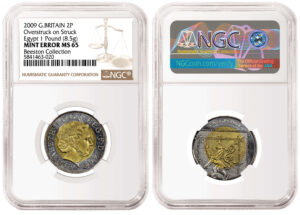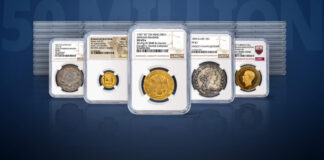Numismatic Guaranty Corporation (NGC) has certified the Beeston Collection, an outstanding set of over 200 British error coins. The coins were recently submitted to NGC UK, the London-based affiliate of NGC.
The Beeston Collection includes many different types of unusual and appealing errors. Nearly all of the errors are from Great Britain, but the collection also includes examples from Jersey, Isle of Man, Gibraltar, Guernsey and Ireland.
Michael Beeston assembled the collection over a period of 20 years. He submitted it to NGC because of its unparalleled expertise in mint errors as well as the security and convenience provided by its London office.
“After careful consideration, I determined that NGC was the best option to certify my collection because of the value provided by their grading services, their ability to preserve my collection’s provenance and the opportunity to showcase my collection in the NGC Registry,” said Beeston. “I am excited that my collection is now publicly available for study in the NGC Registry, and I hope it paves the way for others to follow.”
“The Beeston Collection is the most exciting group of British mint errors that I have ever seen. It stands as a testament to the diligence of the collector in assembling such a unique set of coins,” said NGC Grading Finalizer and renowned mint error expert David J. Camire, who oversaw the certification of the coins in the collection. “The collection includes many rare types, some of which I have never encountered on British coins.”

One coin from the Beeston Collection that shows just how dramatic a mint error can be is a (2015) Great Britain Two Pounds that was double struck with both strikes off center. The coin was struck on the correct bimetallic planchet, but only a small portion of the dies actually struck the planchet near its edge, elongating it.
So little of this coin was struck that it can only be dated because of the birds seen near “1918.” It is graded NGC Mint Error MS 66.

The Beeston Collection also includes examples of errors where the coin is overstruck with the dies of a different denomination. Among them is a 2009 Great Britain 20 Pence that was overstruck on a struck penny. It is graded NGC Mint Error MS 63 RD.
On this error, the letters for the denomination of ONE PENNY can be seen to the right of the queen’s portrait from the obverse of the 20 pence dies. On the other side of the coin, the letters for the denomination TWENTY PENCE are clear, struck over the letters TH II D G, which are part of the inscription ELIZABETH II D G REG. (D G REG is a traditional Latin abbreviation for the phrase “by the grace of God, queen.”)
For collectors of US coins, this would be similar to a planchet being struck first with the correct Lincoln Cent design and then being struck again with the Jefferson Nickel design. However, the diameters of the British penny and 20 pence are much closer: The copper-plated steel penny is 20.3 mm, while the cupro-nickel 20 pence (designed for a heptagonal planchet) is 21.4 mm.

In rare instances, a coin is overstruck with dies used to strike the coins of a different country. This is the case with a Great Britain 2009 Two Pence in the Beeston Collection that was overstruck on an Egyptian One Pound. It is graded NGC Mint Error MS 65.
The dies with the British design struck the coin last and their design can be clearly seen. However, trace amounts of the design originally imparted by the Egyptian dies can be distinguished near the edge of both the obverse and reverse. This includes letters in the words ONE POUND, which appear faintly above the queen’s head.
Although both the British and Egyptian coins have diameters between 25 and 26 millimeters, a bimetallic planchet was not supposed to have been used for this British coin, making the error even more dramatic.
Another exceedingly rare two-country double denomination mint error in the Beeston Collection is a (2013) Great Britain 20 Pence overstruck on a 2012 Trinidad Quarter. Most of the characters in REPUBLIC OF TRINIDAD AND TOBAGO and 2012 are easily identifiable near the edge of the reverse.
The Beeston Collection also features several errors in which parts of the coin are missing, including a stunning 2008 Great Britain 10 Pence, struck on a defective planchet. It is graded NGC Mint Error MS 65.
A large portion of the right side of the coin is missing, with the break on the obverse following Queen Elizabeth’s forehead and nose. This coin entered the collar with the now-missing portion, because otherwise the incredible force of the dies would have pushed metal smoothly into the void.
Sometimes, the strike and planchet are both correct, but something comes between the dies and the planchet. This error is called a strikethrough. The Beeston Collection contains several examples of strikethroughs, including a 1969 Great Britain 50 Pence whose reverse was struck through a fragment of brass (which it retained), as well as a 1978 Great Britain 50 Pence whose obverse was struck through a previously-struck metal fragment. They are graded NGC Mint Error MS 63 and NGC Mint Error MS 64, respectively.
The entire Beeston Collection is proudly shared in the NGC Registry, an online platform where collectors can showcase their coins and view other collections from around the world.
Click here to view the Beeston Collection in the NGC Registry.
You can find further information about NGC UK on their website.




